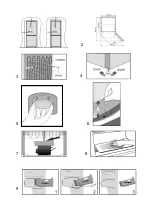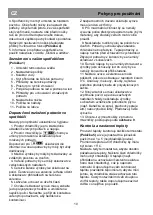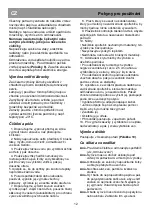
EN
Instruction for use
Do-
Wrap cheese firstly in greaseproof paper and
then in a polythene bag, excluding as much
air as possible. For best results, take out of
the fridge compartment an hour before
eating.
Do-
Wrap raw meat and poultry loosely in
polythene or aluminium foil. This prevents
drying.
Do-
Wrap fish and offal in polythene bags.
Do-
Wrap food with a strong odour or which may
dry out, in polythene bags, or aluminium foil
or place in airtight container.
Do-
Wrap bread well to keep it fresh.
Do-
Chill white wines, beer, lager and mineral
water before serving.
Do-
Check contents of the freezer every so often.
Do-
Keep food for as short a time as possible
and adhere to "Best Before" and "Use by"
etc. dates.
Do-
Store commercially frozen food in
accordance with the instructions given on the
packets.
Do-
Always choose high quality fresh food and
be sure it is thoroughly clean before you
freeze it.
Do-
Prepare fresh food for freezing in small
portions to ensure rapid freezing.
Do-
Wrap all food in aluminium foil or freezer
quality polythene bags and make sure any
air is excluded.
Do-
Wrap frozen food immediately after
purchasing and put it in to the freezer as
soon as possible.
Do-
Defrost food in the fridge compartment.
Don’t-
Store bananas in your fridge
compartment.
Don’t-
Store melon in your fridge. It can be
chilled for short periods as long as it is
wrapped to prevent it flavouring other
food.
Don’t-
Cover the shelves with any protective
materials which may obstruct air
circulation.
Don’t-
Store poisonous or any dangerous
substances in your appliance. It has
been designed for the storage of edible
foodstuffs only.
Don’t-
Consume food which has been
refrigerated for an excessive length of
time.
Don’t-
Store cooked and fresh food together in
the same container. They should be
packaged and stored separately.
Don’t-
Let defrosting food or food juices drip
onto food.
Don’t-
Leave the door open for long periods, as
this will make the appliance more costly
to run and cause excessive ice
formation.
Don’t-
Use sharp edged objects such as knives
or forks to remove the ice.
Don’t-
Put hot food into the appliance. Let it
cool down first.
Don’t-
Put liquid-filled bottles or sealed cans
containing carbonated liquids into the
freezer, as they may burst.
Don’t-
Exceed the maximum freezing loads
when freezing fresh food.
Don’t-
Give children ice-cream and water ices
direct from the freezer. The low
temperature may cause 'freezer burns'
on lips.
Don’t-
Freeze fizzy drinks.
Don’t-
Try to keep frozen food which has
thawed; it should be eaten within 24
hours or cooked and refrozen.
Don’t-
Remove items from the freezer with
wet hands.
Energy Consumption
Maximum frozen food storage volume is
achieved without using the drawers provided
in the freezer compartment. Energy
consumption of your appliance is declared
while the freezer compartment is fully loaded
without using the drawers.
Practical advice concerning the reduction
of the electricity consumption
1. Make sure that the appliance is located in
well-ventilated areas, far from any source of
heat (cooker, radiator etc.). At the same time,
the location of the appliance must be done in
such a way that it prevents it to be under the
direct incidence of the sunbeams.
2. Make sure that the food purchased in
refrigerated/frozen condition is placed into the
appliance as soon as possible, especially during
summertime. It is recommended to use thermal
insulated bags to transport the food home.
3. We recommend the thawing of the packets
taken out from the freezer compartment be
done in the refrigerator compartment. For this
purpose, the packet which is going to be thawed
will be placed in a vessel so that the water
resulting from the thawing does not leak in the
refrigerator compartment. We recommend you
to start the thawing at least 24 hours before the
use of the frozen food.
6
Содержание CSA240M30W
Страница 2: ......
Страница 6: ...2 3 4 5 6 7 8 9 ...
Страница 7: ...10 ...
Страница 51: ......
Страница 52: ...4578336442 AA EN PL CZ SK EST BiH ...














































